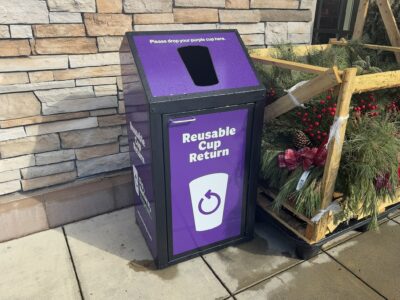In today’s world, production generally moves in a line that leads straight to a garbage bin. We take virgin materials (metals, cotton, plastic), fashion them into products that we only use once or twice, and then dump them when we’re done. There are big problems with this business model: It’s costly, fueled by finite resources, and creates a lot of waste that ends up in landfills or polluting the oceans.
But it doesn’t have to be that way. In a recent event at Columbia University, experts gathered to discuss what it would take to create a circular economy. The event was hosted by the Earth Institute’s Research Program on Sustainability Policy and Management and the multinational financial institution ING, and moderated by Professor Steve Cohen. Watch the video here:
A circular economy would get the most possible use out of each product, through repairs, refurbishing, reuse, upcycling, and long-lasting design. Speaking at the November 8 event, Jean-Charles Guinot from the Ellen MacArthur Foundation used t-shirts as an example. “A t-shirt can be used as a t-shirt, then can be sold as second-hand. If it’s not needed as t-shirt anymore, you can use it as [stuffing for] an armchair or a sofa. And then the third use would be you can use it as insulation [in] a house,” he said.
Not only would a circular economy help to conserve resources and dramatically reduce the amount of trash our society generates, but it would also help to reduce financial waste. Tom Kennedy, a civil engineer from Arup, advises clients to “view waste as a commodity. And you wouldn’t sell a commodity for the lowest dollar value you could. You’d sell it for the highest dollar value you could. And that’s essentially the same principle as the circular economy, is to keep all of the resources you have in the highest possible value circle that you can.”
What Will it Take to Build a Circular Economy?
As great as the circular economy sounds, getting there will require profound transformations in how we do business.
It could start with how we design products, suggested Faith Legendre, a circular economy solutions strategist at Cisco. She suggested that more companies could put leaders in charge of designing for circularity, and that companies should have a plan for and be held responsible for what happens at the end of a product’s life. Planning for disposal needs to happen while the product is being conceived, she said, not tacked on afterwards.
Achieving circularity will require a combination of both rules and incentives for companies, the panel participants agreed.
Legendre suggested that innovation centers and technology incubators could include criteria that judge new product ideas based on what happens at the end of its lifetime. She’d also like to see circularity incorporated into financial ratings systems. But ultimately she thinks regulation will be needed as well. Until producers are held accountable for the full lifecycle of their products, she said, they will continue to make decisions that contribute to sending those products to the landfill.
Anne van Riel, head of Sustainable Finance Americas at ING, said that consumers can also help drive change by choosing to buy more sustainable products and to invest their retirement funds in responsible companies. “I wouldn’t underestimate the power that consumers have,” she said.

When asked whether government intervention is needed, Kennedy highlighted four potential drivers for the circular economy: altruism (doing it because it’s the right thing to do); shareholders (because there’s money to be made from it); market demands; and government. Government is “only one of four strings,” Kennedy pointed out. “We can do it without them, but we have to have everyone together and realize it’s the thing that we want to do, and concentrate on the three other strings, and hope that the government will catch up.”
Finally, Stephanie Kersten-Johnston, adjunct professor in Columbia’s Sustainability Management program and director of Sustainable Business at Heineken USA, suggested a slight rebranding of “sustainability” could help to make the circular economy more appealing. She thinks that for too long, ‘sustainability’ has meant ‘reduction,’ and many people just don’t want to use less. “It’s like trying to choose between going on a diet or choosing a healthy lifestyle. A diet is all about cutting back on what you’re eating—eating less all the time. Whereas a healthy lifestyle you’re looking holistically at what you’re doing and making improvements to your life system… So the end goal may be sustainability of a planet and even our industries and our companies and so on, but it’s just a reframing of how we think about that sustainability approach.”
Signs of Change
The idea of a circular economy may seem very “pie in the sky,” but some companies are already putting circular principles to use—and profiting from it. For example, the fashion industry is the second largest polluter in the world after oil, said Legendre, but new business models are renting out the latest trends; instead of buying a new dress, wearing it once, and then getting rid of it, you can borrow it from a company such as Rent the Runway and send it back when you’re done so that someone else can enjoy it. It’s also a lot cheaper than buying high-end fashion.
Similarly, Kennedy gave the example of Caterpillar, a company that makes construction machinery. He explained that casting metal to create engines is a very energy intensive and wasteful process. A few years ago, Caterpillar started taking back their extra heavy engines and refurbishing them. “They now make more money off the refurbishing than selling the new ones,” he said.
Achieving a truly circular economy across the globe will take time and a lot of change, but the panel participants agreed that it is not only achievable, but necessary for our survival.
“We have to get there at some point,” said Kerston-Johnson, comparing Earth to a boat in the ocean, a self-contained system. “We have one planet, we have these resources, and we can’t afford to be wasting things.”



